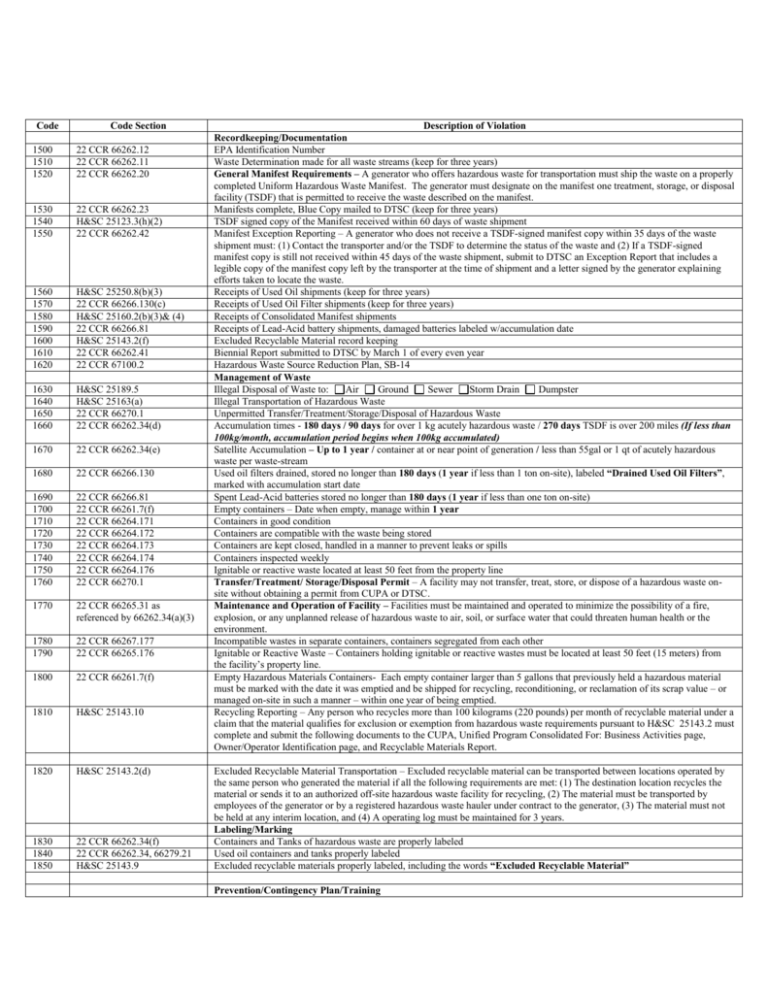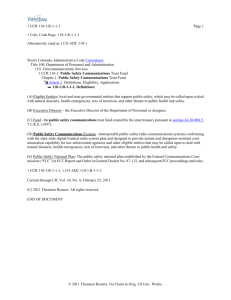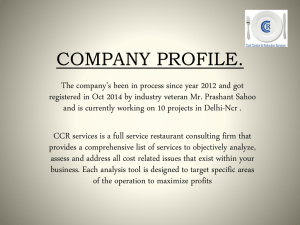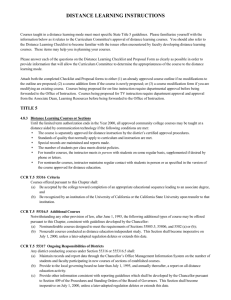Sample Audit Checklist
advertisement

Code Code Section 1500 1510 1520 22 CCR 66262.12 22 CCR 66262.11 22 CCR 66262.20 1530 1540 1550 22 CCR 66262.23 H&SC 25123.3(h)(2) 22 CCR 66262.42 1560 1570 1580 1590 1600 1610 1620 H&SC 25250.8(b)(3) 22 CCR 66266.130(c) H&SC 25160.2(b)(3)& (4) 22 CCR 66266.81 H&SC 25143.2(f) 22 CCR 66262.41 22 CCR 67100.2 1630 1640 1650 1660 H&SC 25189.5 H&SC 25163(a) 22 CCR 66270.1 22 CCR 66262.34(d) 1670 22 CCR 66262.34(e) 1680 22 CCR 66266.130 1690 1700 1710 1720 1730 1740 1750 1760 22 CCR 66266.81 22 CCR 66261.7(f) 22 CCR 66264.171 22 CCR 66264.172 22 CCR 66264.173 22 CCR 66264.174 22 CCR 66264.176 22 CCR 66270.1 1770 22 CCR 66265.31 as referenced by 66262.34(a)(3) 1780 1790 22 CCR 66267.177 22 CCR 66265.176 1800 22 CCR 66261.7(f) 1810 H&SC 25143.10 1820 H&SC 25143.2(d) 1830 1840 1850 22 CCR 66262.34(f) 22 CCR 66262.34, 66279.21 H&SC 25143.9 Description of Violation Recordkeeping/Documentation EPA Identification Number Waste Determination made for all waste streams (keep for three years) General Manifest Requirements – A generator who offers hazardous waste for transportation must ship the waste on a properly completed Uniform Hazardous Waste Manifest. The generator must designate on the manifest one treatment, storage, or disposal facility (TSDF) that is permitted to receive the waste described on the manifest. Manifests complete, Blue Copy mailed to DTSC (keep for three years) TSDF signed copy of the Manifest received within 60 days of waste shipment Manifest Exception Reporting – A generator who does not receive a TSDF-signed manifest copy within 35 days of the waste shipment must: (1) Contact the transporter and/or the TSDF to determine the status of the waste and (2) If a TSDF-signed manifest copy is still not received within 45 days of the waste shipment, submit to DTSC an Exception Report that includes a legible copy of the manifest copy left by the transporter at the time of shipment and a letter signed by the generator explaining efforts taken to locate the waste. Receipts of Used Oil shipments (keep for three years) Receipts of Used Oil Filter shipments (keep for three years) Receipts of Consolidated Manifest shipments Receipts of Lead-Acid battery shipments, damaged batteries labeled w/accumulation date Excluded Recyclable Material record keeping Biennial Report submitted to DTSC by March 1 of every even year Hazardous Waste Source Reduction Plan, SB-14 Management of Waste Illegal Disposal of Waste to: Air Ground Sewer Storm Drain Dumpster Illegal Transportation of Hazardous Waste Unpermitted Transfer/Treatment/Storage/Disposal of Hazardous Waste Accumulation times - 180 days / 90 days for over 1 kg acutely hazardous waste / 270 days TSDF is over 200 miles (If less than 100kg/month, accumulation period begins when 100kg accumulated) Satellite Accumulation – Up to 1 year / container at or near point of generation / less than 55gal or 1 qt of acutely hazardous waste per waste-stream Used oil filters drained, stored no longer than 180 days (1 year if less than 1 ton on-site), labeled “Drained Used Oil Filters”, marked with accumulation start date Spent Lead-Acid batteries stored no longer than 180 days (1 year if less than one ton on-site) Empty containers – Date when empty, manage within 1 year Containers in good condition Containers are compatible with the waste being stored Containers are kept closed, handled in a manner to prevent leaks or spills Containers inspected weekly Ignitable or reactive waste located at least 50 feet from the property line Transfer/Treatment/ Storage/Disposal Permit – A facility may not transfer, treat, store, or dispose of a hazardous waste onsite without obtaining a permit from CUPA or DTSC. Maintenance and Operation of Facility – Facilities must be maintained and operated to minimize the possibility of a fire, explosion, or any unplanned release of hazardous waste to air, soil, or surface water that could threaten human health or the environment. Incompatible wastes in separate containers, containers segregated from each other Ignitable or Reactive Waste – Containers holding ignitable or reactive wastes must be located at least 50 feet (15 meters) from the facility’s property line. Empty Hazardous Materials Containers- Each empty container larger than 5 gallons that previously held a hazardous material must be marked with the date it was emptied and be shipped for recycling, reconditioning, or reclamation of its scrap value – or managed on-site in such a manner – within one year of being emptied. Recycling Reporting – Any person who recycles more than 100 kilograms (220 pounds) per month of recyclable material under a claim that the material qualifies for exclusion or exemption from hazardous waste requirements pursuant to H&SC 25143.2 must complete and submit the following documents to the CUPA, Unified Program Consolidated For: Business Activities page, Owner/Operator Identification page, and Recyclable Materials Report. Excluded Recyclable Material Transportation – Excluded recyclable material can be transported between locations operated by the same person who generated the material if all the following requirements are met: (1) The destination location recycles the material or sends it to an authorized off-site hazardous waste facility for recycling, (2) The material must be transported by employees of the generator or by a registered hazardous waste hauler under contract to the generator, (3) The material must not be held at any interim location, and (4) A operating log must be maintained for 3 years. Labeling/Marking Containers and Tanks of hazardous waste are properly labeled Used oil containers and tanks properly labeled Excluded recyclable materials properly labeled, including the words “Excluded Recyclable Material” Prevention/Contingency Plan/Training 1860 1870 1880 1890 1900 1910 1920 40 CFR 265.31 40 CFR 265.32 40 CFR 265.33 40 CFR 265.34 40 CFR 265.35 40 CFR 265.37 40 CFR 262.34(d) 1930 22 CCR 66565.16(e) 1940 22 CCR 66265.55 1950 1960 22 CCR 66265.52 as referenced by 22 CCR 66262.34(a)(3) 22 CCR 66265.53 1970 22 CCR 66265.16 1980 1990 2000 22 CCR 66273.11 22 CCR 66273.14 22 CCR 66273.15 2010 2020 2030 22 CCR 66265.192 22 CCR 66265.195 22 CCR 66265.191-66265.196 Facility maintained and operated to minimize fires, explosions, and releases Facility has internal communications, way of summoning emergency assistance, and fire and spill control equipment All communication or alarm systems, fire and spill control, and decon equipment be tested and maintained Employees have immediate access to internal alarm/comm. systems (If only1 employee, access to external) Aisle space maintained for personnel, fire and spill control and decontamination equipment Owner or operator has made arrangements with local emergency response authorities Emergency coordinator available, emergency info posted by the phone, and employees familiar with waste handling and emergency procedures Retention of Training Records – Hazardous waste management training records on current personnel must be kept until closure of the facility. Records on former employees must be kept for at least 3 years from the date the employee last worked at the facility. Emergency Coordinator – At all times there must be at least one employee either on the premises or on call with the responsibility for coordinating all emergency response and reporting activities. This Emergency Coordinator must have the authority to carry out the Contingency Plan and be familiar with the facility and all records within the facility. Contingency Plan Prepared/Complete – The facility must have a written plan that is kept current. Copies of Contingency Plan – Copies of the plan and any revisions to it must be maintained at the facility and submitted to appropriate emergency response agencies. Personnel Training – All personnel at the facility involved in the management (i.e. generation, transfer, shipment, etc.) of hazardous waste must receive classroom instruction or on-the-job training in the proper management of hazardous waste. Universal Waste (batteries, lamps, thermostats, consumer electronic devices as def. in 22 CCR 66273.2-66273.6) Illegal disposal, dilution, or treatment of Universal waste Universal waste marked or labeled to indicate the type of Universal waste Accumulation time – 1 year (generator must be able to demonstrate how long a waste has been accumulated) Aboveground Hazardous Waste Tanks Tank system is designed to hold hazardous waste w/o collapsing or failing(Engineer’s assessment, good for 5 yrs) Tank inspected each operating day (this must be documented) Tank must have secondary containment as per 66265.193 and be assessed by a certified engineer as described in 66265.192 unless facility meets Non-RCRA exemption. Facility must complete exemption form for Non-RCRA waste. Tank must be operated to prevent spills, mixing of incompatibles, and not used if unfit.





